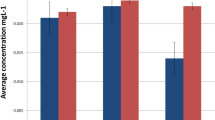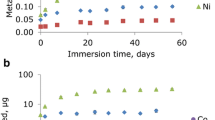Abstract
The orthodontic kinetic release of metal ions was studied in order to have a conclusive in vivo data for variation of metal ion concentrations with time (month) at normal oral temperature 37°C, which affects the saliva quality and quantity, pH, and chemical and physical characteristics of food and liquid. The superficial breakdown and release of metals from the alloy brackets were investigated by scanning electron microscopy (SEM) and energy dispersive X-Ray spectroscopy (EDS) images. The kinetic release experiment of the metal ion concentrations (nickel, chromium, titanium, iron, and copper) in the saliva uptakes follows a pseudo-second-order kinetic model; the release rate of metal ions was in series Fe2+ > Ti2+ > Ni2+ > Cu2+ > Cr3+, and the highest saliva pH and flow rate were detected after 1 month for fixed orthodontics appliance was (7.16 ± 0.55) and (0.88 ± 0.55) respectively.





Similar content being viewed by others
Data availability
All the saliva specimens were taken from participants.
In vivo kinetic study of 20 participants including ten males and ten females in the age range (15–35) years old with several malocclusion necessity to be treated by fixed orthodontic appliance in Erbil city-Kurdistanregion/Iraq during the period between September 2017 and December 2018.
References
Arash V, Pouramir M, Hajiahmadi M, Mirzafarjooyan S (2012) Measurement of iron, magnesium and chromium concentrations in the saliva of the patients undergoing fixed orthodontic treatment. 2012.
Anusavice KJ (1996)Philips’ Science of dental materials, 10th edn. WB Saunders, Phildelphia, p 566
de Almeida PDV, Gregio A, Machado M, De Lima A, Azevedo LR (2008) Saliva composition and functions: a comprehensive review. J Contemp Dent Pract 9(3):72–80
Dwivedi A, Tikku T, Khanna R, Maurya RP, Verma G, Murthy R (2015) Release of nickel and chromium ions in the saliva of patients with fixed orthodontic appliance: An in-vivo study. Nat J Maxillofac Surg 6(1):62
Edgar W (1992) Saliva: its secretion, composition and functions. Br Dent J 172(8):305–312
Fors R, Persson M (2006) Nickel in dental plaque and saliva in patients with and without orthodontic appliances. Eur J Orthod 28(3):292–297
Humphrey, Williamson (2001) A review of saliva: normal composition, flow, and function. J Prosthet Dent 85(2):162–169
Joseph A (1997), In Corrosion of orthodontic devices, Seminars in orthodontics, Elsevier; pp 198-205.
Karnam SK, Reddy AN, Manjith C (2012) Comparison of metal ion release from different bracket archwire combinations: an in vitro study. J Contemp Dent Pract 13(3):376–381
Lara-Carrillo E; Montiel Bastida NM; Sánchez Pérez L; Alanís Tavira J, (2010), Effect of orthodontic treatment on saliva, plaque and the levels of Streptococcus mutans and Lactobacillus. 2010.
Mikulewicz M, Chojnacka K (2011) Release of metal ions from orthodontic appliances by in vitro studies: a systematic literature review. Biol Trace Elem Res 139(3):241–256
Rudney J (1995) Does variability in salivary protein concentrations influence oral microbial ecology and oral health? Crit Rev Oral Biol Med 6(4):343–367
Schipper RG, Silletti E, Vingerhoeds MH (2007) Saliva as research material: biochemical, physicochemical and practical aspects. Arch Oral Biol 52(12):1114–1135
Acknowledgements
My deepest appreciation and gratitude to the Ministry of Higher Education and Scientific Research, Directorate of Quality Assurance Accreditation, and Higher Education Council of Salahaddin University and Hawler Medical University-Erbil, and I would like to appreciate the Ministry of Health in the Kurdistan region, Rizgary Hospital Erbil, and all the participants in this medical scientific work.
Funding
This study was funded by [me].
Author information
Authors and Affiliations
Contributions
The author contributed to the study conception and design. Material preparation, data collection, and analysis were performed by [Shireen Ibrahim Hamadamin]. The first draft of the manuscript was written by [Shireen Ibrahim Hamadamin] and I read and approved the final manuscript.
Corresponding author
Ethics declarations
Ethics approval
The key points relating to ethics approval in this research taking permission from 20 human subjects is not harm.
Consent for publication
The author is consent to publish: Individuals may consent to participate in a study, but object to having their data published in a journal article. Authors should make sure to also seek consent from individuals to publish their data prior to submitting their paper to a journal. This is in particular applicable to case studies.
Competing interests
The author declares no competing interests.
Additional information
Responsible Editor: Philippe Garrigues
Publisher’s note
Springer Nature remains neutral with regard to jurisdictional claims in published maps and institutional affiliations.
Rights and permissions
About this article
Cite this article
Hamadamin, S.I. In vivo kinetic release of five metal ions (iron, titanium, nickel, copper, and chromium) from fixed orthodontic alloys in Erbil city-Kurdistan region/Iraq. Environ Sci Pollut Res 29, 11730–11735 (2022). https://doi.org/10.1007/s11356-021-16479-6
Received:
Accepted:
Published:
Issue Date:
DOI: https://doi.org/10.1007/s11356-021-16479-6




